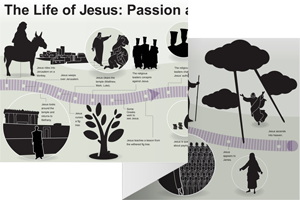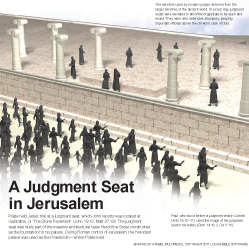19:1–16 Even though he is certain that Jesus is innocent, Pilate sentences Him to be crucified at the insistence of the crowd, fearing an uprising if he does not. |
19:1 flogged See note on Matt 20:19. The Greek verbs used for the punishment may allude to the Septuagint of Isa 50:6, which refers to the physical punishment of the Suffering Servant.
19:2 crown of thorns An instrument of mockery and, likely, torture.
purple robe The soldiers use this symbol of royalty to mock Jesus, because the religious leaders asserted that He claimed to be “king of the Jews” (18:33).
19:5 Behold the man Pilate may be ironically pointing out the weakness of Jesus; He hardly appears to be a king at this moment. John’s audience, however, knew the truth.
19:7 law Refers to Lev 24:16. In John 10:33, Jesus’ Jewish opponents wanted to kill Him because He made claims they regarded as blasphemous (compare 5:18).
Son of God The Jews believed that Jesus, by professing to be the Son of God, was claiming to be God’s chosen king, His representative on earth. Pilate would have understood this claim in relation to Caesar being called “son of God”—that is, as a claim to be king of the whole earth, to be godlike, and to have ultimate authority. See note on 10:36.
19:8 he was even more afraid Pilate’s worst fear would have been a Jewish uprising against Roman rule—a potential result of a revolutionary claiming to be the rightful king.
19:11 given to you from above Jesus claims that all authority comes from God. Since Jesus is one with the Father, He also is claiming that Pilate’s authority is from Him (1:1–4; see note on 17:2).
19:12 not a friend of Caesar The Jewish authorities knew that this accusation would prompt Pilate to sentence Jesus to death.
19:13 The Stone Pavement The place from which Pilate issued public decrees. It likely was an elevated platform connected to the governor’s residence.
19:14 day of preparation Friday, the day before the Sabbath of Passover week.
the sixth hour According to Mark, Jesus was crucified at the third hour (9 a.m.; Mark 15:25, 33).
19:17 The Place of a Skull See note on Mark 15:22 and note on Matt 27:33.
19:20 Aramaic The majority of Judaeans would have understood this language. See note on John 5:2.
Latin The official language across the Roman Empire. Government documents, well-educated people, and the Roman military and guard used Latin.
Greek The common language of commerce and writing used in the eastern part of the Roman Empire.
19:25 Mary the wife of Clopas Nothing is known of this Mary outside of this passage. The Greek term translated “wife” allows for the interpretation that she is either Clopas’ wife or mother. Nothing more is known of Clopas.
Mary Magdalene Jesus exorcised seven demons from Mary (Luke 8:2). “Magdalene” likely derives from the name of the place she was from.
(Luke 8:2). “Magdalene” likely derives from the name of the place she was from.
19:26 disciple whom he loved Likely refers to John. See note on John 13:23.
19:27 Behold your mother Suggests that Mary had been following her son during (at least) this portion of His ministry and was relying on Him and His disciples for support. Her husband, Joseph, might have died by this time.
19:29 sour wine This indicates a cheap wine and might allude to Psa 69:21. Compare Mark 15:36.
branch of hyssop Used by Jews to smear the blood of their Passover lamb over their doorposts. This would deter the angel of destruction from taking their firstborn (Exod 12:22).
19:30 It is completed Jesus knows that God’s plan for Him has reached its completion—He has done what He came to earth to do (compare John 17:4–5).
19:31 day of preparation See note on John 19:14.
Sabbath The Jewish authorities are so calloused that they are more concerned with their religious day and their place in the celebrations and remembrances than they are about Jesus’ unwarranted death (see 12:42–43).
important day See note on Gen 2:3.
their legs could be broken Crucifixion was an intentionally long and painful death. When people were crucified, their feet and hands would be nailed to the cross. With the rib cage and lungs stretched out, people would need to put weight on their legs to lift themselves up and make it easier to breathe. If someone stayed alive for what was deemed too long on a cross, executioners would break their legs.
19:33 did not break his legs Like the Passover lamb, none of Jesus’ bones are broken (Exod 12:46; see note on John 1:29; note on v. 29).
19:34 pierced his side with a spear Fulfills the prophecy in Zech 12:10, which parallels Jesus’ role as the Suffering Servant via the connection in Zech 3:8–9 (see Isa 11:1–12 and note; Zech 3:8–9 and note; Isa 53:1 and note; compare John 12:38).
blood and water came out In including this detail, John may be emphasizing that Jesus was truly human (1:14) or that life and cleansing power come from the blood of Jesus (see 6:53–56; 7:38–39).
19:38 Joseph See note on Luke 23:50–56.
19:39 mixture of myrrh and aloes May have been used to embalm His body and linen shroud. The myrrh was likely imported from Arabia, and it may have been tapped from trees and used in a powdered form (see note on Mark 15:23; note on Prov 7:17). Matthew reports that the magi brought myrrh as a gift for the infant Jesus, marking the beginning of His life (Matt 2:11); now, myrrh marks His death.
aloes Probably imported from India; used for embalming His body and linen.
hundred pounds This amount represents a very costly burial (see note on John 19:41).
19:40 fragrant spices Spices were meant to reduce the smell of decay. This was an expensive burial ritual (compare note on 12:3).
19:41 a new tomb This fulfills the prophecy that the Suffering Servant would be rich in his death (Isa 53:9). Only wealthy people had tombs, and only the very wealthiest people had new tombs.

|
About Faithlife Study BibleFaithlife Study Bible (FSB) is your guide to the ancient world of the Old and New Testaments, with study notes and articles that draw from a wide range of academic research. FSB helps you learn how to think about interpretation methods and issues so that you can gain a deeper understanding of the text. |
| Copyright |
Copyright 2012 Logos Bible Software. |
| Support Info | fsb |
 Loading…
Loading…


